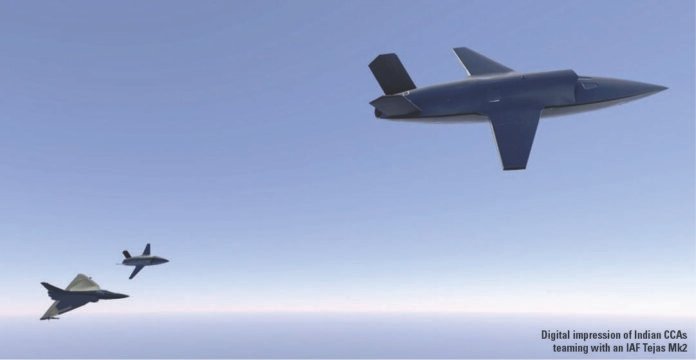Imagine a pair of sleek, stealthy aircraft flying high over the Himalayan horizon in the not so distant future. As you zoom in close, you astonishingly realise there’s no pilot in the cockpit. This pair of robotic platforms calmly weave invisible patterns, dancing to the tune of an unknown composer. Only the trained eye can relate this as tactical manoeuvring against a beyond visual range (BVR) entity. This carries on for a while, till such time that a sleek Tejas fighter jet zooms in and joins up with the uncrewed platforms in a perfect finale to the composition.
As the two robotic platforms tuck in obediently behind the Tejas, you realise that you are witnessing a first-hand manifestation of manned unmanned teaming (MUM-T), and the two uncrewed systems are none other than the Hindustan Aeronautics Limited (HAL) CATS-Warrior and its smaller sibling, the NewSpace Research & Technologies (NRT) developed Abhimanyu. Warrior and the Abhimanyu define the emerging breed of uncrewed air combatants widely termed as ‘Collaborative Combat Aircraft (CCA)’ and in some geographies, as the ‘Loyal Wingman’.
The CCAs are the byproducts of a rapidly developing air warfare doctrine in the age of Industry 5.0. They’re designed to fly alongside traditional 4/4.5/5th Gen fighters, taking on some of the toughest missions and making sure they stand as a barrier of contact between the home team and the opposition for a variety of operational needs. The HAL Warrior and the NRT Abhimanyu epitomise disruptive trajectories of CCA development across the world, where the United States is the global leader. While the definitive operational deployment of these futuristic platforms is still some years away, the one thing which is obvious is that CCAs are poised to change modern air combat as we know it.
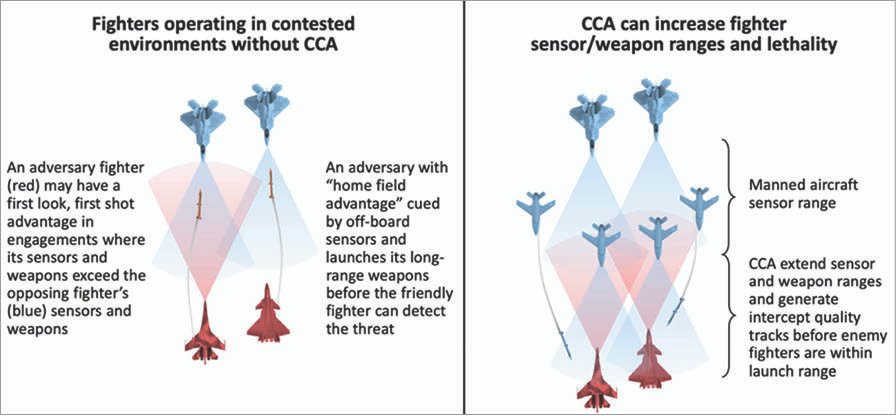
Understanding the CCA Concept
For decades, the world has pictured fighter jets dominating the discourse on the command of the skies, and advancements in air warfare doctrine. But with the advent of Collaborative Combat Aircraft, the airpowers across the world are changing that narrative, registering the next big thing in Air Warfare. Expanding on the definition of the CCA – Collaborative Combat Aircraft are advanced, autonomous, or semi-autonomous systems engineered to work in tandem with traditional manned aircraft such as fighter jets, bombers and/or C2 assets; as well as terrestrial entities. These Uncrewed Combat Air Vehicles (UCAV) are equipped with sense and perception sensors, collaborative autonomy, edge computing, artificial intelligence (AI), and networked protected data links; enabling them to perform a wide variety of roles — from reconnaissance and electronic warfare, to strike missions and air defence suppression; and as air to air combat vectors equipped with Air-to-Air Missiles. CCAs are mostly powered by jet engines and can be deployed solo or in a swarm.
Unlike traditional drones, which often operate independently or under direct human control, CCAs are designed to collaborate with other CCA/ UAVs and with human pilots in a dynamic manned unmanned teaming (MUM-T) and wider autonomy paradigm. In the days ahead, pilots would command a CCA swarm to scout ahead, jam enemy radars, or engage hostile targets, keeping the aircraft out of the harm’s way while the pilot focuses on higher-level decision-making. This complex set of manoeuvres and tactical routines will be implemented thorough a ‘system of systems’ philosophy.
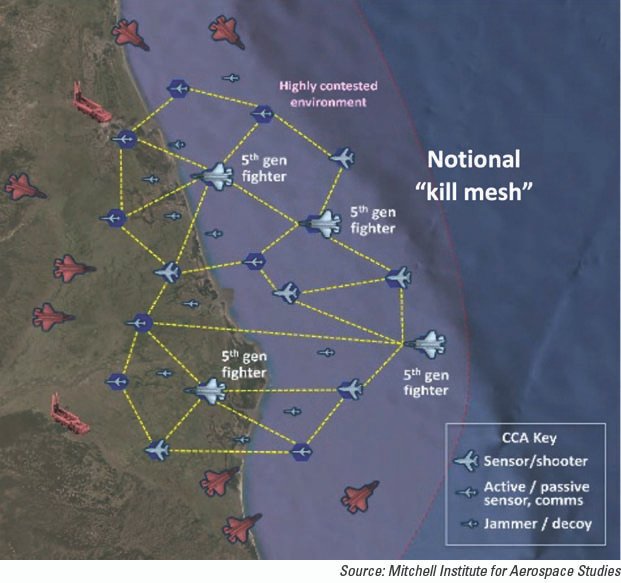
Today’s 4/4.5/5th Gen manned platforms are ‘exquisite, expensive and available in fewer numbers’ to create a widespread impact. Recent conflicts reinforce the emergence of Anti-Access and Area Denial (A2AD) layered offence/ defence philosophies, which imposes caution on use of these platforms, especially the ability to generate a sizeable ‘mass’ and ‘air launched effects’ (ALEs) to penetrate the A2AD layers without suffering disproportionate attrition.
Reintroducing the philosophy of affordable and de-centralised ‘combat mass’, CCAs will be able to disaggregate sensors and payloads across dispersed, less ‘exquisite’ vehicle types within the same swarm. Thus CCAs increase the density of sensors, weapons, and other mission systems that can be projected in depth inside contested zones. CCAs can enable non-stealthy fighters and bombers to contribute to the highly contested air superiority fight as a team. They can prove their lethality by helping to close sensor – weapon range gaps and achieve first look/ first shoot advantage.
The CCAs are expected to be most effective when utilised as part of kill meshes, to increase survivability and lethality against enemy assets. Kill meshes would increase options for manned fighters to detect, avoid, and counter enemy defences in 360-degree threat environments. Creating a more heterogeneous force mix, sharing sensing, data links, and other functions across meshes would complicate an enemy’s ability to identify nodes and other targets. Employing large numbers of lower cost CCA could help deplete enemy air defences, impose costs, and open the path to follow-on crewed and uncrewed force vectors. Imagine the advantage of an entire fighter squadron, where only one or two aircraft have human pilots, and the rest are CCAs. They seamlessly follow commands, thanks to AI-driven software, delivering the Air Force’s combat punch to achieve Air Superiority in hostile space.
The CCAs are the byproducts of a rapidly developing air warfare doctrine in the age of Industry 5.0. They’re designed to fly alongside traditional 4/4.5/5th Gen fighters, taking on some of the toughest missions and making sure they stand as a barrier of contact between the home team and the opposition for a variety of operational needs
Tackling Old Problems with New Ideas
It’s interesting to watch where the USAF, the current CCA development champion is headed in this vertical. The US DOD realises that Aircraft are expensive to develop, buy, and operate. Since the 1990s, the USAF fleet has decreased, in part because of those costs. Former Air Force Secretary Kendall has stated CCAs would cost roughly one-third the price of crewed fighters. Kendall added that there is a “planning assumption” of 1,000 CCAs, a number derived by projecting the use of two CCAs for each of 500 advanced fighters. CCAs are part of the Air Force’s Next-Generation Air Dominance (NGAD) family of systems program, which also may include a future crewed fighter platform, sensors, weapons, and more.
The USAF is envisioning that training on CCAs would occur virtually, so the airframes themselves would fly less, potentially leading to lower maintenance and sustainment costs. The Air Force would purchase them in quantities large enough to augment its fleet. CCAs arrive just as China’s aerospace and defence industry is on a massive research & rearmament up drive, where its contribution to the anti-access/area-denial (A2/AD) strategies—think long-range missiles and sophisticated air defence—are challenging the US air superiority. By integrating CCAs with crewed fighters, the USAF believes it can create a larger, more flexible, and more obscure force for adversaries to deal with, helping in A2AD penetration methodologies.
Further, in line with a new approach called agile combat employment (ACE), the Air Force wants to disperse and scatter forces across multiple small bases instead of relying on large, centralised locations which are under threat from Chinese long range precision strike complexes. CCAs in dispersed locations will add sensors, weapons, and enough options to deploy, which will keep potential adversaries guessing. The Commander of Air Combat Command General Kenneth S. Wilsbach sums it well -“You can create mass, and so many targets out in the battlespace that your adversary will have to worry about … is that something that I have to use some munitions on?”

Foundational Development in the United States
The Defence Advanced Research Projects Agency (DARPA), the USAF, and Air Force Research Laboratory (AFRL) have undertaken numerous efforts to develop and test single agent and collaborative autonomy software and modular upgradable platforms during the past decade. What is significant to note is that the USAF has sought to develop a pipeline of technologies feeding into the CCA. These efforts helped to refine underlying technologies such as digital engineering, agile software, and open mission systems. Programs like DARPA’s ACE combat and AFRL’s Skyborg have delivered the building block for the same. The Air Force has a dedicated experimental test unit working on developing the best ways to use CCAs, including using its X-62 VISTA fleet to experiment with the autonomy software undergirding CCAs. These projects have collected data and conducted artificial intelligence (AI) experiments to help teach pilots how autonomous software behaves and reduce risk for CCA mating.
The Kratos XQ-58 Valkyrie, in operation since 2019, was the world’s first CCA concept to start autonomy & human machine teaming trials with AFRL, and has demonstrated its advanced electronic attack capabilities by autonomously detecting, identifying, and geolocating multiple targets of interest. In one of the demos, the aircraft successfully transmitted target track coordinates to collaborative assets and executed non-kinetic electronic attack (EA) effects against multiple emitters. The XQ-58A Valkyrie offers high performance, runway-independent tactical UAV capabilities, including long-range flights at high-subsonic speeds, operational flexibility, and affordability for various US DOD applications.
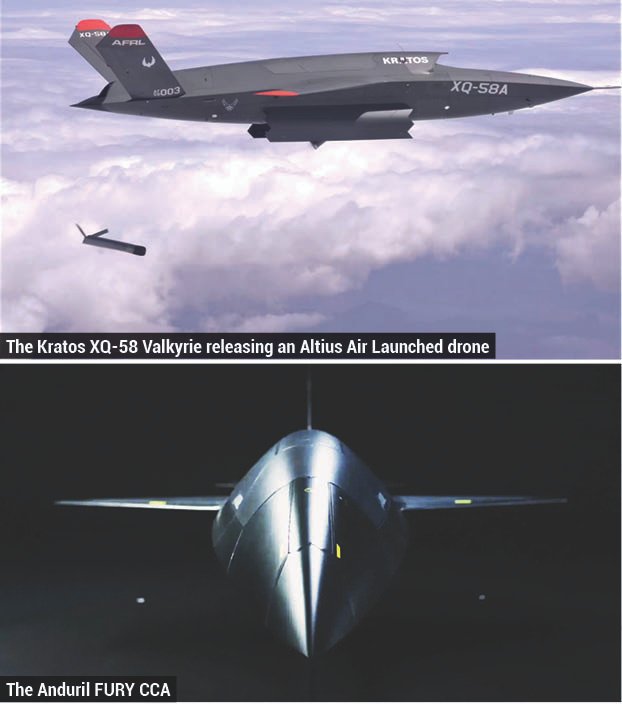
In January 2024, the USAF awarded initial contracts to five companies to design and build CCAs: Anduril, Boeing, GA-ASI, Lockheed Martin, and Northrop Grumman. In April 2024, the Air Force announced that two of those companies—Anduril, and GA-ASI—won Increment 1 contracts to build production-representative test articles. Anduril made headlines when it acquired Blue Force Technologies, the developer of a large uncrewed aircraft called Fury. The Fury is now slated for a makeover, evolving into a high-performance, and multi-mission aircraft under Anduril’s guidance. The company plans to pair Fury with its ‘Lattice’ intelligence software suite—an open system that can tie together multiple sensors and domains. Meanwhile, General Atomics has built on its XQ-67A test platform, which first flew in early 2024. It focuses on endurance, rather than raw speed or manoeuvrability. In fact, GA-ASI’s leaders say they’ve already started production, hinting at the pace of innovation taking place behind the scenes.
The USAF anticipates ordering more than 100 CCAs as part of Increment 1 program award in the next five years. The vendors not selected would still be eligible to compete for Increment 1 production contracts and future increments. The preliminary work has started on Increment 2. The USAF intends to work with more than 20 industry partners, including those not initially selected for Increment 1, and is additionally exploring international partnerships. The Increment 2 award could be a more complicated platform that incorporates stealth technologies.
Reintroducing the philosophy of affordable and de-centralised ‘combat mass’, CCAs will be able to disaggregate sensors and payloads across dispersed, less ‘exquisite’ vehicle types within the same swarm. Thus CCAs increase the density of sensors, weapons, and other mission systems that can be projected in depth inside contested areas
Lockheed Martin recently announced that it successfully demonstrated the capability to command drones with a MUM-T architecture resident on board an F-35 in 2024. The company conducted tests with a human controller in an L-39 Albatros jet using a touchscreen interface to command two L-29 Delfin jets, equipped with AI-enabled flight technology acting as surrogate drones, to engage simulated enemy fighters. In fact the Kratos XQ-58 CCA has on many occasions flown besides the F-22 and F-35 fighters of the USAF and the Marine Corps.
The showcasing of the XQ-58A Valkyrie’s ability to fly alongside two F-35 aircraft and deliver an integrated electronic attack capability during a live flight test event, marked the completion of the initial phase of the US Marine Corps’ Penetrating Affordable Autonomous Collaborative Killer – Portfolio (PAACK-P) program on April 2, 2024, with a successful demonstration by its Unmanned Systems Division at Eglin Air Force Base, Florida. The F-35 can command and control up to 8 CCAs under its existing capability.
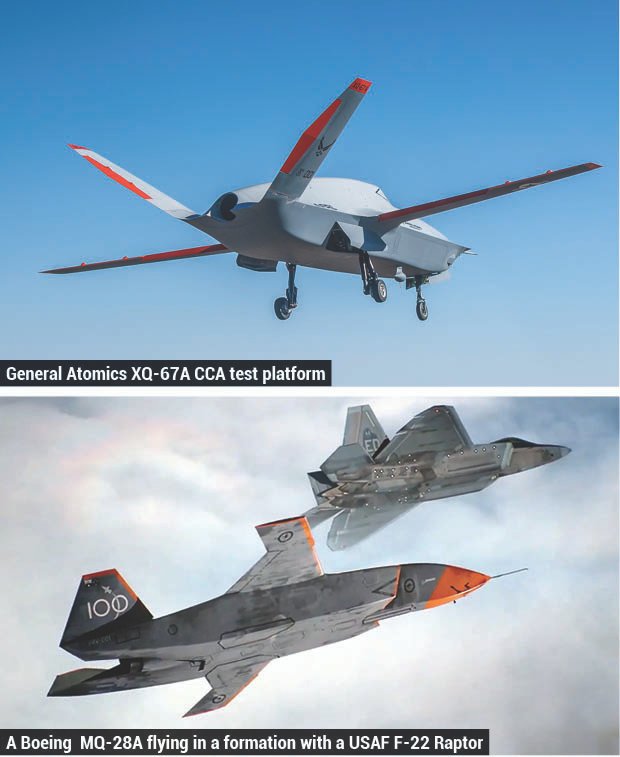
Development Trajectory Across Rest of the World
In Europe, the CCA development by several European nations is primarily focused on the “Future Combat Air System (FCAS)” program, which aims to create a network of manned and unmanned aircraft capable of seamlessly collaborating in combat operations, utilising advanced technologies like AI and big data for enhanced situational awareness and decision-making. Key players in the FCAS project include France, Germany and Spain. FCAS will be built around a core Next Generation Weapon System (NGWS). In this system of systems, piloted New Generation Fighters will work together with the newly unveiled Airbus CCA design, and with Unmanned Remote Carriers – all connected to other systems in space, in the air, on the ground, at sea and in cyberspace via a data cloud called the “Combat Cloud.”
These connected platforms will act as sensors, effectors and C2 nodes, enabling agile decision making and working together within an open, scalable, architecture that allows the inclusion of future platforms and technologies. FCAS capabilities will roll out incrementally, starting with enhanced situational awareness in the late 2020s and progressing to manned-unmanned teaming in the early 2030s. Upgraded fighters such as the Eurofighter will team with first-generation Wingman, leading to the full FCAS vision by 2040 with the NGWS.
UK, Italy and Japan are developing CCA capabilities around the multi-national Global Combat Aircraft Program. The GCAP envisions a swarm of Loyal Wingman/ CCA class aircraft being interoperable with the Tempest 6th Gen fighter aircraft. CCA designs from BAE Systems, Leonardo and Mitsubishi Heavy Industries (MHI) have emerged centred around this requirement which focuses on creation of a crewed and uncrewed platform based connected and dynamic combat mass to saturate and penetrate enemy defences.
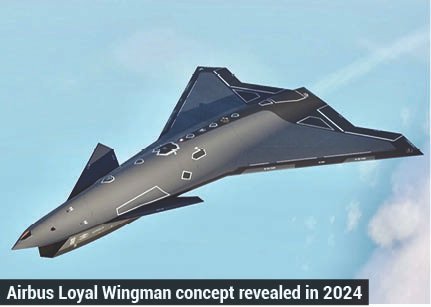
Australia has developed the Boeing MQ-28A ‘Ghost Bat’ Loyal Wingman, which is touted as a pathfinder for integration of autonomous systems and AI to create smart human-machine teams. It is the result of a collaboration between Australian Air Force and Boeing Australia.
In December 2024, the Swedish firm Saab presented concepts for a potential new-generation crewed fighter and a series of CCA drones intended to work alongside it. With a long history of domestic combat aircraft development, a sixth-generation fighter and complementary stealthy drones make sense for Sweden, although there are big questions about whether this is a realistic prospect without joining forces with other countries.
Turkey is prototyping a CCA based on the Baykar Kizilelma (Red Apple). It is being designed to work alongside the Turkish KAAN 5th Gen manned fighter jet, providing additional situational awareness, carrying out specific tasks like electronic warfare, and potentially engaging enemy targets under the command of the manned aircraft. The Kizilelma is under flight testing and has a maximum take-off weight (MTOW) of 6,000 kilograms, with 1,500 kg of weight available for the payload. According to data shared by the company, the Kızılelma will have an operational altitude of 10,000 meters AMSL.
South Korea’s KAI is involved in development of the KUS-FS, a Loyal Wingman class low RCS UCAV designated to operate with the locally developed 4.5/5th Gen KF-21 Boramae fighter aircraft. It is still at a conceptual stage and will only be operational towards the end of the decade.
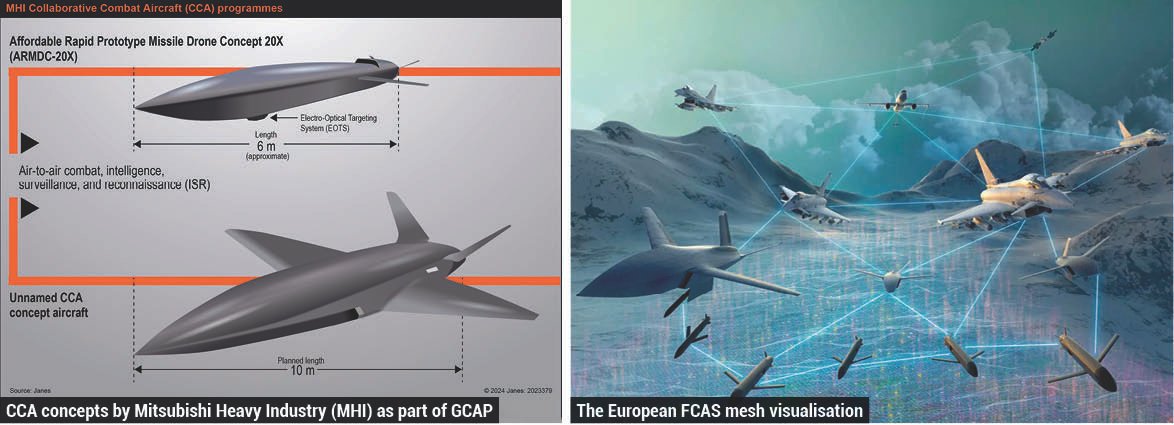
The Russian Sukhoi bureau is developing the S-70 Okhotnik-B, also referred to as Hunter-B, which is a Russian UCAV being transitioned into a CCA concept around the development of the 5th Gen Su-57 platform. The concept relies on MUM-T to add robotic layers tied to the Su-57 and exploit the same at a tactical level. On October 5, 2024, an S-70 was shot down by an air-to-air missile from a Russian Su-57, near Kostiantynivka, in Ukraine. The drone apparently lost contact with its ground control and flew in the direction of Ukrainian-controlled territory. By the time attempts to regain control had been abandoned, the drone had crossed the front line into Ukraine and, subsequently, the Russian Su-57 deliberately shot it down. Russia though will continue developing the S-70 in the days ahead, albeit at a reduced pace, limited by sanctions and tech gaps.
China’s “intelligentised warfare” doctrine emphasises AI, autonomy, and networked systems to counter US military advantages in the Indo-Pacific. Collaborative drones and CCAs are a key component of this strategy and have started appearing in Chinese whitepapers on air warfare. While China has not officially confirmed a program named “collaborative combat aircraft,” its investment in stealth UAVs, AI, and swarm technology suggests active development of systems analogous to the Loyal Wingman concept. These platforms aim to enhance the lethality and survivability of China’s 5th-gen fighters like the J-20 in high-threat scenarios. With the unveiling of two 5+/6th Gen fighters in Dec 2024, it can safely be assumed that China is testing a series of CCA concepts out of the public eye to support deployment of its next generation fighters.
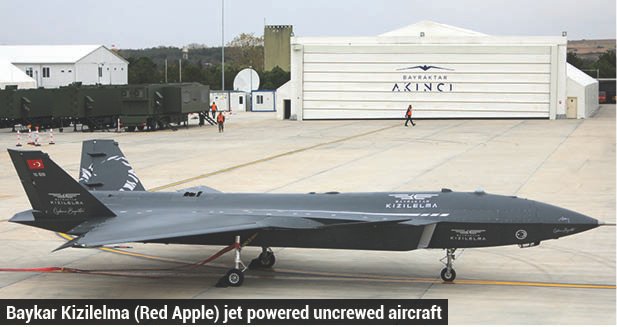
The GJ-11 “Sharp Sword” Stealth UAV will be one of them; which is a flying-wing stealth combat drone revealed in 2019, capable of internal weapons carriage. It is speculated to operate alongside stealth fighters like the J-20 for penetrating enemy air defences and conducting strikes on US assets in the Indo – Pacific region. The FH-97 Loyal Wingman unveiled at the 2022 Zhuhai Air Show resembles the US Skyborg /XQ-58A Valkyrie. It features AI-driven swarm coordination, air-to-air missile capabilities, and modular payloads and is designed to act as a sensor node/ weapons carrier for manned fighters. Another concept is the ‘Dark Sword’ (Anjian), a rumoured high-speed, stealthy CCA under development with potential air-combat capabilities. Its status remains unclear, but it highlights China’s interest in advanced AI-driven combat drones paired with manned elements.
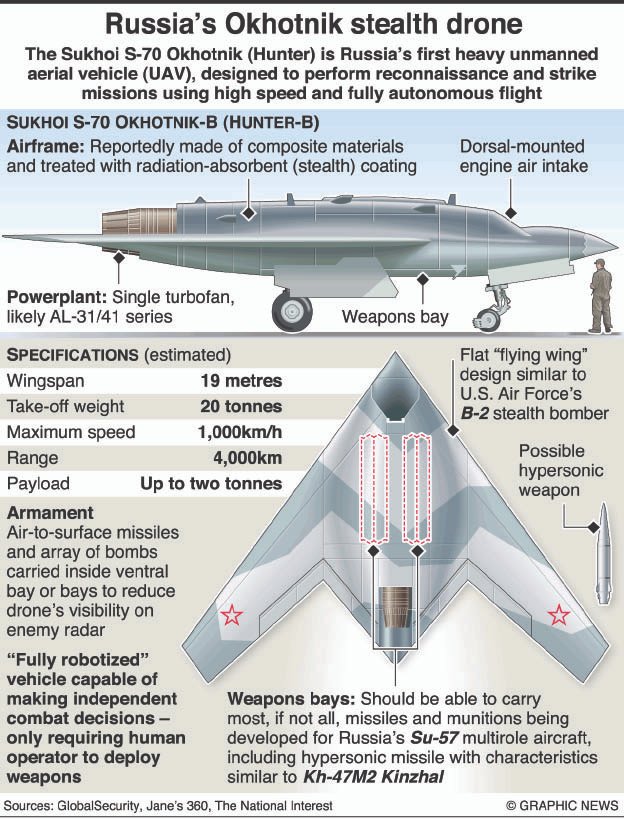
From Interaction to Automation, to Challenges with Higher Echelons of Autonomy & AI
What is yet to be seen is how the CCAs will be controlled and what levels of autonomy may truly be available in the near term to support the Concept of Operations (ConOps). There is a lot of opinion amongst the Air Forces about the right way to go about doing this. On Human Machine Interface (HMI) protocols, the universal thought is that the fastest way to begin experimentation would be a tablet or a touch based interface in the cockpit, and most of the CCA Command & Control (C2) interfaces in manned cockpits are taking this route.
However effort will needed to integrate the HMI in a most intuitive and cognition friendly manner at the aircraft mission avionics level so as to not overload the pilot from his core job of flying the aircraft. These system architectures can only come out of clinical experiments on the subject. One such initial effort is operational in the F-35 cockpit, while futuristic concepts using Augmented/ Virtual Reality (AR/VR) are being explored with programs like the UK’s GCAP.
The CCAs are expected to be most effective when utilised as part of kill meshes, to increase survivability and lethality against enemy assets
The inference on how much autonomy is enough for the CCA agent would ideally depend on what best result it is able to deliver in a teaming environment. It will also be dependent on the quality of the data crunched to train and augment the AI algorithms and associated combat autonomy development processes, some of which may not be currently available in the real world. Here besides real world testing effort, high fidelity simulation environments with training and experimentation of next generation autonomy and ConOps implementation for CCAs will help save effort, ambiguity and costs.
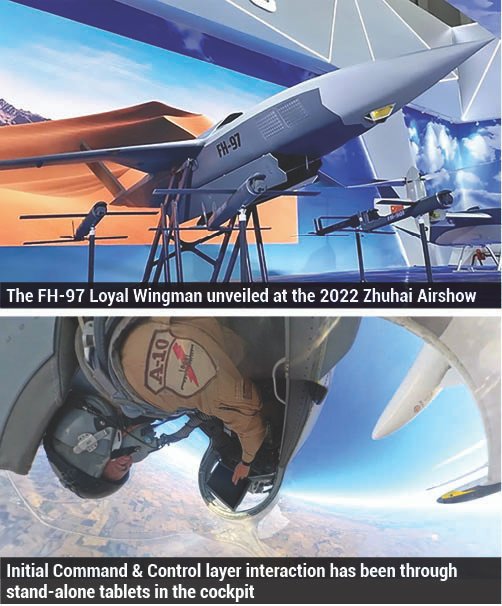
What is however emerging as a feedback from early CCA experiments is that at this juncture, an efficient automation process, with a lower level of autonomy and AI support, can still deliver the desired tactical result in a most useful manner. This will especially be pertinent with most nations emphasising on a human decision for key engagement decisions, including employment of weapons. It also understates the fact that the ability to create systems which can operate autonomously with missions in all regimes of operations, is something which is still maturing.
When we evaluate the trust and ethical behaviour of the resident intelligence on the robotic entity, the explainability of AI and trusted hard coded behaviour trumps the very advanced layers of autonomy which cannot be understood on how they take decisions. With a better grasp of evolving CCA doctrine, technology mapping and other fundamentals, a single manned fighter can control a ‘larger’ number of drones than previously thought with proven facets of automation, using less-sophisticated autonomous technology. Not only can pilots embed with a larger numbers of CCA drones, but they also won’t need drones with the most cutting-edge autonomy software to do it. Reliance on emergent behaviour using AI methods with unsupervised learning, will be limited to exclusive scenarios only, with the majority of actions like navigation, collaboration of agents, group combat tactics etc., centred around playbook routines and behaviour trees, which are explainable.
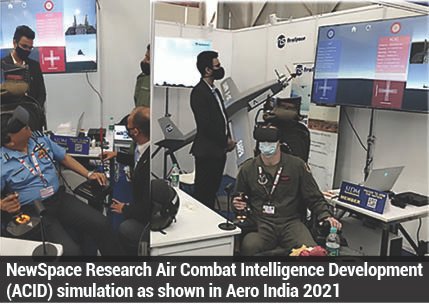
Hence, what was clearly thought as the necessary requirement for a great amount of autonomy and a significant amount of artificial intelligence, and really, really complex algorithms, has with widespread virtual and real world workflow deployments turned out to be instead – ‘automation support, simple autonomy, simple algorithms, a little bit of AI sprinkled in.’ This has been verified to a great deal in the USAF autonomy experiments. The experiment teams have been able to decrease pilot workload to a degree where they can effectively utilise these capabilities. The USAF calls the development “probably the most exciting part” of the CCA program so far, because it opens up more options for how the Air Force can employ the current generation of drones. Complex behaviours can wait for ‘tomorrow’, mapped to the technology implementation trajectory of the future.
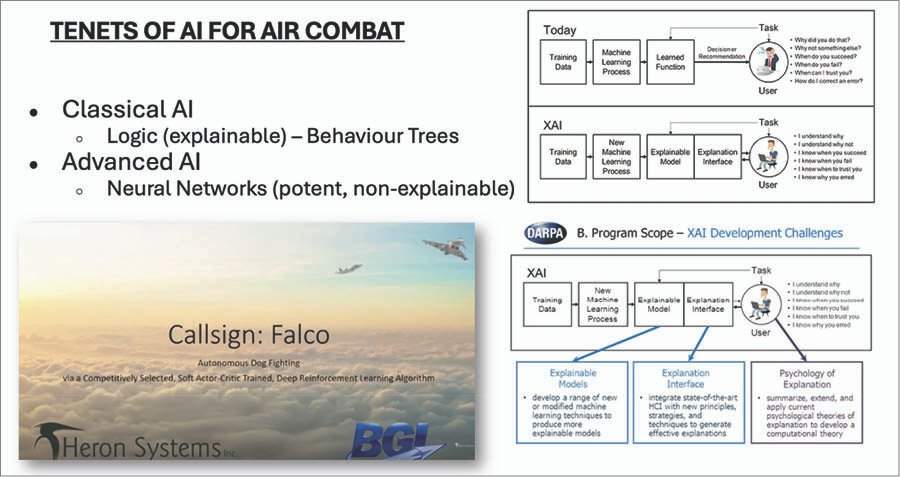
The CCA Advantage for India
The Indian Air Force (IAF) faces a critical challenge with its dwindling fighter squadron strength (currently 30–32 squadrons against a sanctioned of 42). This shortage affects the IAF’s operational readiness given threats from China and Pakistan in a two front war scenario. Especially against China, the IAF is the first line of defence and offensive action over the Tibet Autonomous Region (TAR). With the IAF not being able to afford a doctrine that seeks to match the PLA aircraft-for-aircraft, a shortfall in Indian Air Force mission capacity will massively increases the risk for all Indian inter service joint force operations. No other service can bring enough combat air capacity to fill existing gaps. Thus the IAF must develop asymmetric capabilities and operating concepts that prevent PLAAF from achieving its campaign objectives against India using operational mass.
Collaborative Combat Aircraft (CCA) and loyal wingman drones like India’s indigenous Hindustan Aeronautics Limited (HAL) CATS – Warrior, could play a transformative role in mitigating this gap while modernising the force and preserving force levels. “Mass” has long been a crucial theme behind the CCA program and pairing each manned fighter like the Rafale, Tejas MK2, or the 5th Gen AMCA with 2–3 low-cost CCAs will effectively multiply combat capacity without requiring more human pilots or expensive platforms. That provides an answer to China’s growing force size, and presents the Chinese with a more complex targeting challenge against larger number of rival aircraft dispersed across the pan Indian region, thus reducing the IAF’s attrition in highly contested environments.
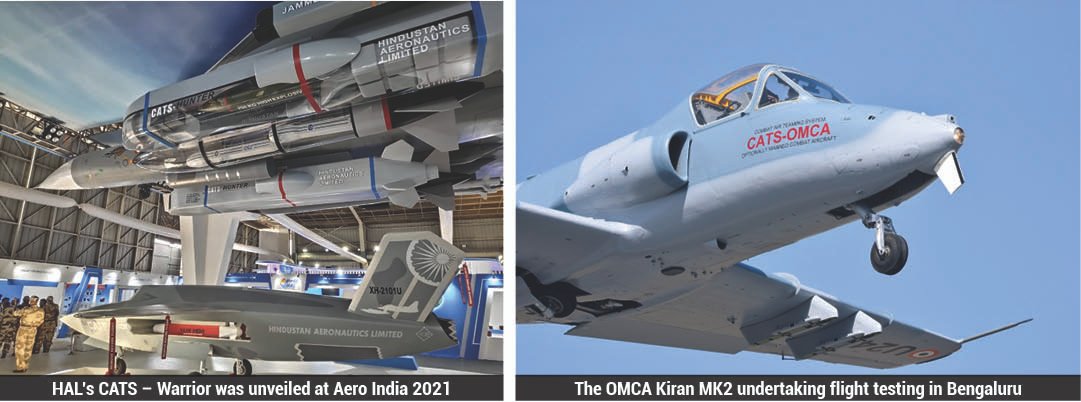
CCAs are cheaper to produce and maintain than 4/5th Gen fighters. India’s Warrior program aims for a per-unit cost of USD 5 –10 million, compared to USD 60–100 million for a Rafale class platform. At the same time, mass production of modular CCA platforms could offset the IAF’s squadron shortages much faster than either procuring foreign jets from outside India or expecting HAL, India’s lone aircraft manufacturer, to ramp up production capacity beyond what may be feasible.
The Indian Air Force is aware of this predicament and has supported HAL’s CAT – Warrior Unmanned Wingman development since some years now. HAL unveiled the Warrior concept as part of its futuristic Combat Air Teaming System (CATS) in February 2021 and has been steadily developing capabilities to design and scale up the Technology Readiness Level (TRL) of the prototype vehicle. HAL achieved a significant milestone in the programme with the successful completion of the engine ground run of a full-scale demonstrator ahead of Aero India 2025, where the prototype is set to be unveiled.
Reliance on emergent behaviour using AI methods with unsupervised learning, will be limited to exclusive scenarios only, with the majority of actions like navigation, collaboration of agents, group combat tactics etc., centred around playbook routines and behaviour trees, which are explainable
The Warrior will have a MTOW of 1300 kg and a top speed of 850 kmph, a max range of 800 km and an endurance of 80 min. It is currently powered by 2 x PTAE-7 turbojets locally manufactured by HAL. The system envisages the Tejas Light Combat Aircraft (LCA) as the “mothership” controlling a network of autonomous platforms, including the CATS-Warrior, which is a low-observable unmanned combat aerial vehicle (UCAV). Over a period of time, the Warrior will be armed with the NG-CCM and the ASRAAM air to air missiles, the DRDO SAAW anti runway glide bomb, and the NRT ALFA-S swarm drone system.
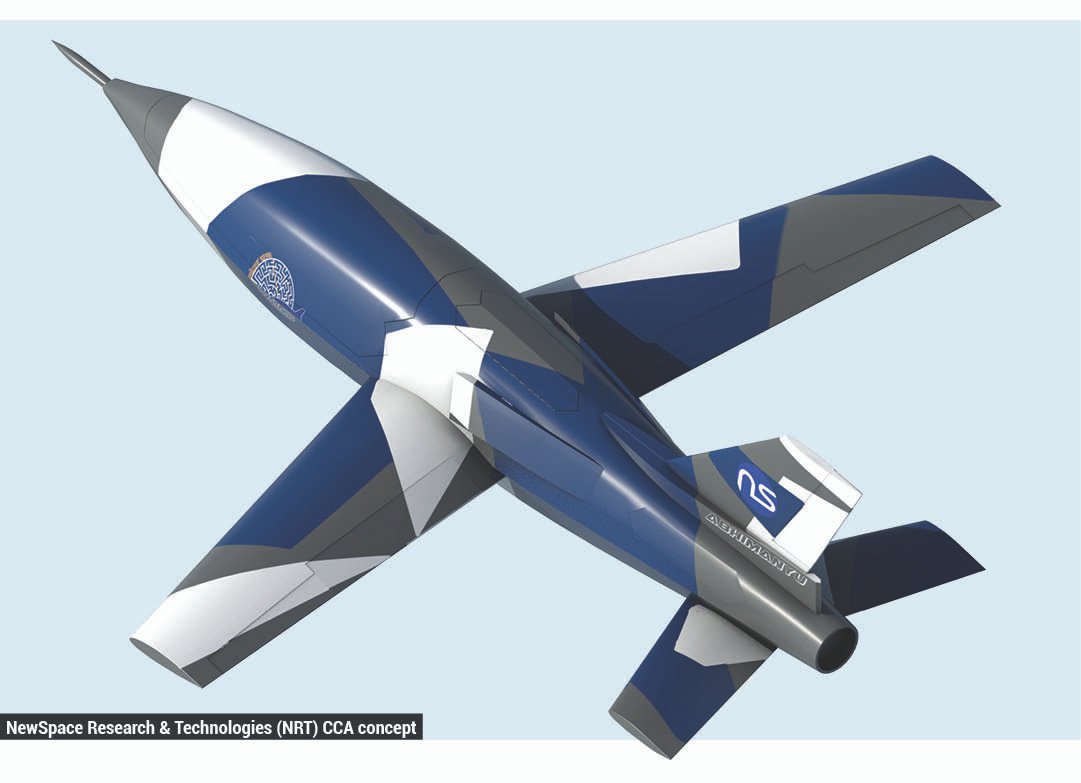
HAL is carrying out the development of the unmanned flight stack of the Warrior on a surrogate Kiran MK2 technology testbed aircraft. The Optionally Manned Combat Aircraft (CATS-OMCA) is undertaking flights to prove the technologies and thus increase the program TRL. The OMCA in itself will be productised in an unmanned wingman role as it becomes technologically mature.
The Indian Navy recently selected NewSpace Research & Technologies Pvt Ltd (NRT), a start-up company based out of Bengaluru as its choice to develop the Naval Collaborative Combat Air Vehicle (N-CCAV) through the Indian MoD’s Innovation For Defence Excellence (iDEX) Aditi 2.0 challenge route. NRT will be pushing forward its Abhimanyu CCA under the N-CCAV mandate.
The development of the Warrior and Abhimanyu CCAs by Indian companies is a milestone event for the UAV sector in India, with a clear intent to push for integration of CCAs into India’s larger Defence strategy – particularly in scenarios that demand rapid deployment and scalability of airborne uncrewed systems
The Abhimanyu, which is a jet powered low RCS design, is expected to be a smaller and lighter drone as compared to HAL’s Warrior with a mandate to deliver human machine teaming missions with the Indian Navy’s Mig-29K and other suitable aircraft. Its modular design can be adapted to perform a variety of roles, including surveillance, EW and kinetic attacks. Abhimanyu, which is designed to be cost effective and expendable, can be rapidly produced and deployed in large numbers to augment the existing fighter fleet of both the Indian Navy and the Indian Air Force. These connected platforms can act as sensors, effectors and C2 nodes, enabling agile decision making within an open, scalable, operations oriented architecture, which will allow inclusion of future platforms, technologies and ConOps.
Catalysing Aatmanirbhar Bharat
Although currently a work in progress, the development of the Warrior and Abhimanyu CCAs by Indian companies is a milestone event for the UAV sector in India, with a clear intent to push for integration of CCAs into India’s larger Defence strategy – particularly in scenarios that demand rapid deployment and scalability of airborne uncrewed systems. Here the Services, DRDO and its associated labs, along with HAL and the industry partners need to put in synergised efforts to develop and test the required combat autonomy and AI implementations, as well propose a modular spiral/ upgradable route towards procurement; much in the way the US ecosystem has supported the CCA development. This will catalyse and consolidate technologies needed to scale the development of the eco system for this genre of platforms along with development of associated sensors, payloads, subsystems and allied tech in India.
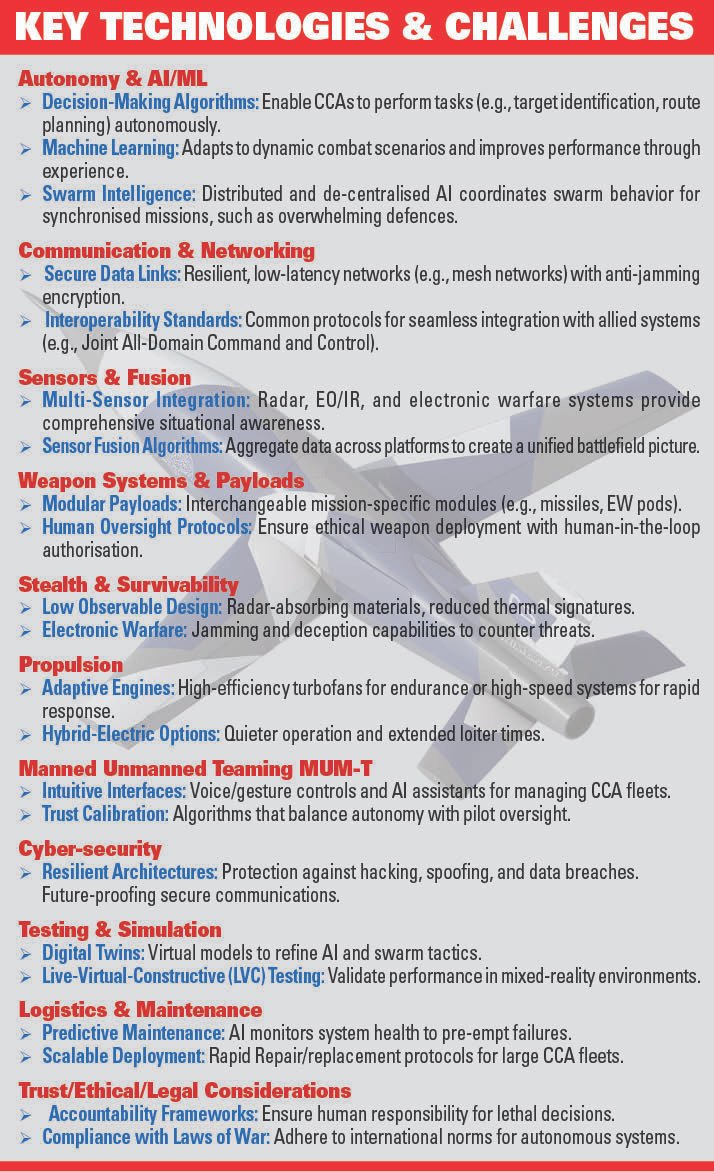
It should be well understood that unmanned wingmen and CCAs are not a replacement for manned fighters, but a strategic force multiplier that can help the IAF offset squadron shortages, modernise cost-effectively, and counter peer adversaries like China. By prioritising indigenous programs like Warrior and Abhimanyu, which foster AI innovation and enhance air combat effectiveness, India can bridge its capability gap and position itself as a leader in autonomous technologies. Hence the Indian MOD needs to assess CCA design and cost trade-offs to define high fidelity requirements, and a persistent appetite to support this initiative. The key lies in balancing urgency with technological pragmatism, supported by a dedicated budget and end user mandate.
The Warrior and the Abhimanyu programs underscore India’s ambition to modernise its air operations with cutting-edge home grown sovereign hardware; while balancing affordability and strategic autonomy as a nation.
The Warrior and the Abhimanyu programs underscore India’s ambition to modernise its air operations with cutting-edge home grown sovereign hardware; while balancing affordability and strategic autonomy as a nation
Defining a New Chapter in Air Power
As the airpowers across the globe gear up to field these unmanned teammates, it’s clear that the Collaborative Combat Aircraft is more than just a showpiece on the drawing board. With its fangs bared, CCA represent a fundamental shift in how nations will project power in contested skies. By combining human pilots with AI-enabled agents, the early adopters will be able to project cutting edge technologies in a world where adversaries are quickly catching up.
This next era of air combat is still taking shape. Budgets will evolve, technology will push boundaries, and questions about autonomy, and related trust and ethical usage will spark debates. But one thing is certain: CCAs have the potential to redefine what an air force looks like and how it wins the fight for the command of the skies in the next decade.

